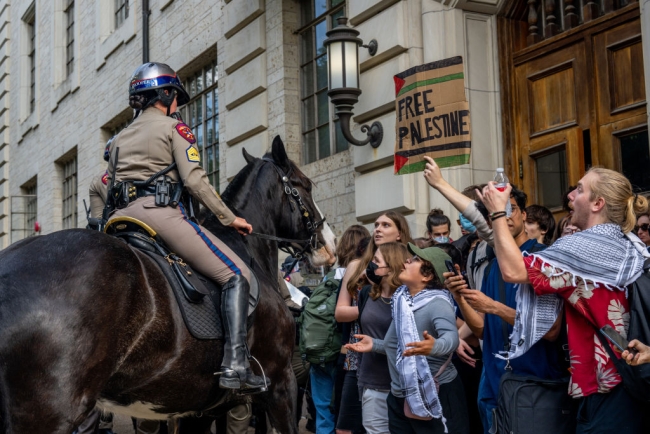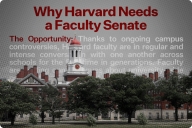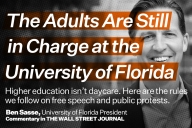You have /5 articles left.
Sign up for a free account or log in.

Mounted police confronted protestors at the University of Texas at Austin on April 24.
Brandon Bell/Getty Images News/Getty Images North America
Student protesters at campuses across the country are increasingly being met with arrests, not just at Columbia University, but at places like the State University of New York at Stony Brook, the University of Minnesota, and the University of Texas at Austin, along with many other campuses. In many of these cases, the arrested students were taken to a local jail until bail could be posted. In almost all cases, the rules violated were procedural or vague.
How do America’s universities even possess the means to respond so swiftly to student protests with police action? The answer lies partly in the history of student protests of the 1960s, a moment in U.S. history when access to public higher education was spreading rapidly to a growing and diverse group of new students, including more students from lower-income families, international students and students of color. University administrators responded to this new student population and the powerful student protests of the 1960s by becoming the architects of new professionalized internal police forces that took root in our colleges in the 1970s. These new campus police departments would serve as a key piece in the mission to maintain order within higher education and hopefully keep institutions out of national headlines.
Spoiler alert: It isn’t working. Universities are now back in the public spotlight, grabbing headlines not just nationally but internationally. And as they grapple with this spotlight, administrators are working within the narrow confines of an apparatus constructed in reaction to student protests of the 1960s. They have at the same time specifically, but unsuccessfully, relied upon a makeshift matrix of bureaucratic rules and regulations to control student protests. This turn toward a bureaucratic order paired with punitive consequences for student protesters has a price for our campuses: the risk of criminalizing speech and preventing independent critical thinking.
Student protests have taken place as long as universities have existed. Accounts of disruptive, unapproved, chaotic, peaceful and nonpeaceful campus protests are all over the historical record both in the United States and abroad. Protests during the colonial period, the Civil War, and throughout the nineteenth century might surprise most. In 1934, protesting students at City College of New York responded to the arrival of the New York Police Department with chants of “Cops off the campus!” “Cops off the campus!”
Then came 1964 and The Free Speech Movement at the University of California, Berkeley. For the rest of the 1960s, campus protests on an array of issues took hold. Some protesters supported the Vietnam War; some opposed it. Some called for civil rights; some aggressively opposed that movement. Some centered the longer-standing critique of the university-military industrial complex; some centered a desire to move away from the concept of the “multi-versity.” Others wanted the disruption to stop and wanted a university that was insulated from the increasingly changing outside world. By 1967, op-eds across the country began to warn of another wave of campus rebellions.
On Jan. 14, 1969, about 70 Black University of Minnesota students, after months of raising issues related to discrimination, decided to protest the lack of serious engagement with their concerns by occupying the bursar’s and records office for 24 hours. The subsequent prosecution of some of the participating students—who were charged with “aggravated criminal damage to property, rioting, and unlawful assembly”—sparked further protests by thousands of students and community members.
That same year, at the University of Wisconsin-Madison, Black students called for a campus-wide student strike until administrators agreed to 13 demands. Along with “thousands of white allies,” they held rallies, boycotted classes, marched to the state Capitol, took over lecture halls and blocked building entrances, leading the governor to activate the Wisconsin National Guard.
This brings us to Kent State University in 1970, where students were protesting Richard Nixon’s decision to invade Cambodia, prompting the governor to call in the National Guard. On May 2, the campus Reserve Officers’ Training Corps building burned down. On May 3, Ohio Governor James Rhodes called the protesters “the worst type of people that we harbor in America.” On May 4, the National Guard fired 67 shots on the student protesters: four students were killed, and nine more were injured.
The last time universities faced this degree of widespread protest and public backlash, they spent the next two decades deeply entrenched in the project of improving their internal security apparatuses. Through that project, many institutions of higher learning decided, for the first time, that they needed to construct their very own police forces, highly trained but reformulated to fit the educational setting of a university.
These alternative police forces, in the minds of university administrators, would culminate in the best of law enforcement. They gradually gained standard arrest powers, the ability to be armed at all times, and expanded jurisdictions. Once administrators designed such forces and put them into play, their campus-based police forces would possess the ultimate legitimacy in the eyes of students, faculty, staff and the larger public when enacting a swift and increasingly militarized police response. The continuous threat of campus shootings and concerns over sexual assault further rationalized their presence. More than two-thirds of four-year universities and colleges in the United States would come to have sworn and armed campus police departments, in most cases with jurisdictions beyond campus grounds. These departments often mirror those of traditional law enforcement in organization, recruitment processes, and protocols. However, they report to and are accountable to university officials.
In short, after the 1970 massacres at Kent State and then Jackson State University at the hands of various law enforcement agencies, universities decided the answer would reside in the development of a different type of police force. (Indeed, Columbia recently gained headlines partly because the decision to bring in the New York Police Department harkened back to an antiquated and unsuccessful model of calling city or local police on to campuses.) This time around, a professional, highly trained and capable internal police force has already been developed at many institutions.
The administration’s reliance on this policing apparatus (whether internal or external) is clearly being met with substantial critique. The strategies of the protesters are similar (in fact some might argue less intense than the 1960s), and university presidents are facing similar political blowback (some might argue more intense than the 1960s): however, what’s different is the policing apparatus is already built, professionalized, and normalized. As a result, administrators’ response has been to further bureaucratize protest—to insist, for example, that students map out their protest routes and plans to such detail that any deviation makes them susceptible to removal by campus police.
Student protesters, from the 1960s through today, understand the university to be fundamentally imbricated in the larger social, political and economic worlds they inhabit. From here, a familiar historical pattern reemerges: Campus protests that began as demonstrations against U.S. involvement in international affairs and university complicity in financing death and destruction abroad become protests about the arrests of student protesters on university grounds. For some protesters, this consequence further illuminates the interconnected nature of struggle.
As university administrators, staff and faculty struggle to make sense of this moment, historical research suggests it is critical to note three things. First, our analytical frame must be expanded to not just include but center large, public institutions. These institutions educate the majority of American students and provide access to an education for those who have historically been denied it. Second, this latest wave of protest serves as a reminder of the long history in which university administrators have called upon a network of law enforcement agencies to stop student protest. Third, in responding to student protests today, many universities rely on their own highly trained police forces alongside a strategy that aims to bureaucratize protest. Yet the degree to which this apparatus cannot resolve the fundamental question of how to balance academic freedom and student safety is abundantly clear.








